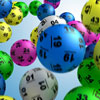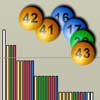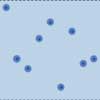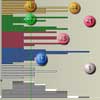Submitted by david on Tue, 05/02/2008 - 10:51am
Suppose there are $aN$ lottery tickets sold, each with a chance $1/N$ of winning.
Submitted by david on Tue, 05/02/2008 - 10:49am
 Consider a lottery in which there are $N$ possible number combinations - in the UK Lottery $N $= 13,983,816. Each ticket therefore has a $1/N$ chance of sharing in the jackpot. Suppose we sell $N$ tickets, what is the chance of nobody winning the jackpot? What if we sell $2N$? The chances are shown in the table below, and hold whatever $N$ is, provided it is large!
Consider a lottery in which there are $N$ possible number combinations - in the UK Lottery $N $= 13,983,816. Each ticket therefore has a $1/N$ chance of sharing in the jackpot. Suppose we sell $N$ tickets, what is the chance of nobody winning the jackpot? What if we sell $2N$? The chances are shown in the table below, and hold whatever $N$ is, provided it is large!
Submitted by david on Fri, 11/01/2008 - 5:46pm
 The UK National Lottery began on 19th November 1994 and there had been 1242 draws up to 20th October 2007. The jackpot prize is won by choosing in advance the 6 numbers drawn from a set of balls numbered from 1 to 49.
The UK National Lottery began on 19th November 1994 and there had been 1242 draws up to 20th October 2007. The jackpot prize is won by choosing in advance the 6 numbers drawn from a set of balls numbered from 1 to 49.
Submitted by arciris on Fri, 21/12/2007 - 2:08pm
Author: John Haigh
Available in most book stores, at a cost of approximately ?, no real maths needed but you will get through more of it if you are patient and pay attention to the maths he tries to explain to you
Submitted by david on Wed, 07/11/2007 - 5:31pm
National Lottery Level 3 showed how the standard [math]\chi^2[/math] goodness-of-fit statistic could be adjusted to allow for non-independence induced by the need to have exactly six unique numbers appear at each draw.
Submitted by david on Wed, 07/11/2007 - 5:28pm
 In Lottery Expectations we looked at the observed and theoretical distributions for the total count of times each number has come up, and the gap between a number's appearances. Here we explain the mathematics behind the theoretical distribution of counts, and how to check for true randomness, and derive the theoretical distribution for gaps.
In Lottery Expectations we looked at the observed and theoretical distributions for the total count of times each number has come up, and the gap between a number's appearances. Here we explain the mathematics behind the theoretical distribution of counts, and how to check for true randomness, and derive the theoretical distribution for gaps.
Submitted by david on Wed, 07/11/2007 - 4:08pm
 National lottery shows how many times each of the numbers has come up in the main National Lottery draw, and what were the gaps between appearances of each number. Here we look at whether the observed distribution of the number of times each of the 49 numbers has come up fits with what would be expected with a truly random draw, and whether the gaps also correspond to what might be expected.
National lottery shows how many times each of the numbers has come up in the main National Lottery draw, and what were the gaps between appearances of each number. Here we look at whether the observed distribution of the number of times each of the 49 numbers has come up fits with what would be expected with a truly random draw, and whether the gaps also correspond to what might be expected.
Submitted by david on Wed, 07/11/2007 - 3:59pm
 The UK National Lottery began on 19th November 1994 and there had been 1240 draws up to 20th October 2007. The jackpot prize is won by choosing in advance the 6 numbers that will be drawn from a set of balls numbered from 1 to 49. We can use the history of the lottery to illustrate many aspects of the theory of probability: how each draw is individually unpredictable, and yet the overall history shows predictable patterns; how a `league table' of numbers can be created that appears to show some numbers are preferentially drawn, and yet the table is completely spurious; how to test whether the balls are truly being drawn at random; how extremely unlikely events will occur if you wait long enough, and so on.
The UK National Lottery began on 19th November 1994 and there had been 1240 draws up to 20th October 2007. The jackpot prize is won by choosing in advance the 6 numbers that will be drawn from a set of balls numbered from 1 to 49. We can use the history of the lottery to illustrate many aspects of the theory of probability: how each draw is individually unpredictable, and yet the overall history shows predictable patterns; how a `league table' of numbers can be created that appears to show some numbers are preferentially drawn, and yet the table is completely spurious; how to test whether the balls are truly being drawn at random; how extremely unlikely events will occur if you wait long enough, and so on.
